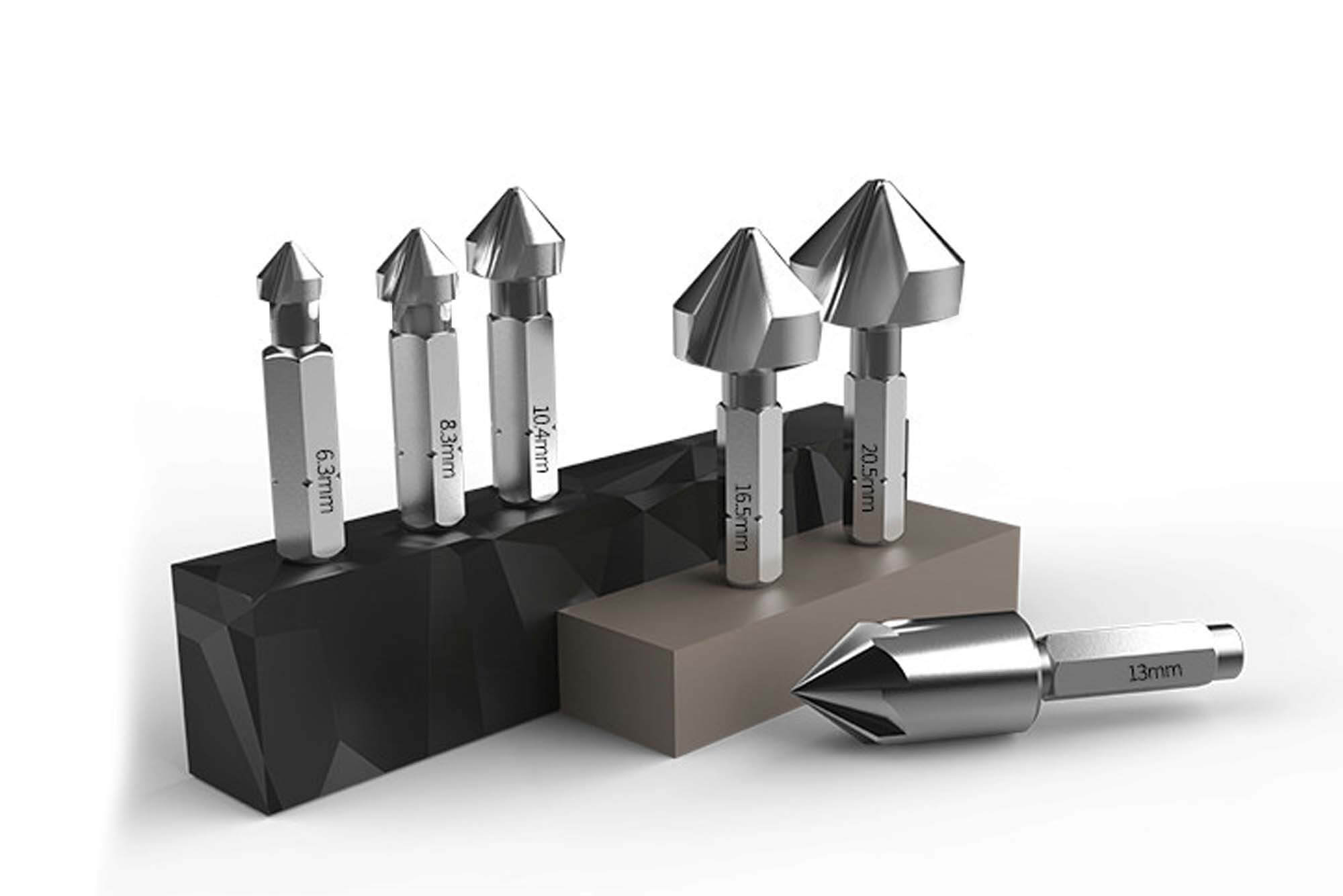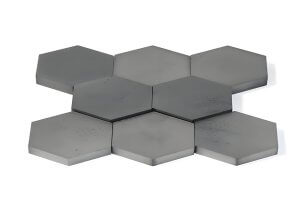In the world of CNC machining, precision is everything. Whether you’re crafting complex components for aerospace or simple fixtures for everyday use, the attention to detail can make all the difference. Among the many tools employed in CNC machining, chamfer bits are essential for creating clean, beveled edges. These tools play a key role in improving the safety, assembly, and aesthetic appeal of CNC-produced parts.
Choosing the right chamfer bit for your project isn’t always straightforward. Factors like material type, chamfer angle, and even the bit’s durability can impact the final result. This article will guide you through the key aspects to consider when selecting the best chamfer bit for optimal edge processing, ensuring your CNC operations are both efficient and precise.
What is a Chamfer Bit? The Essential Tool for Chamfering in CNC Machining
A chamfer bit is a specialized cutting tool used in CNC machining to create a beveled edge, or chamfer, on a workpiece. Chamfering helps to remove sharp edges, improving both the safety and appearance of parts. In some cases, it also aids in the assembly of components, especially where a tight fit is required.
Functionality of Chamfer Bits
Chamfer bits work by cutting a sloped edge at a specified angle, typically 45 degrees, although other angles are also used depending on the application. The chamfering process can be performed on a wide range of materials, including metals, plastics, and wood.
Chamfering is crucial in industries where precise part assembly is necessary, such as aerospace, automotive, and medical devices. Beyond functional reasons, chamfering also adds an aesthetic finish, making products look more refined.
Advantages of Using Chamfer Bits in CNC Machining
Chamfer bits offer numerous advantages in CNC machining, particularly when edge quality and safety are paramount.
2.1 Improved Edge Processing
Chamfer bits make it possible to process the edges of a workpiece more smoothly, reducing the likelihood of burrs or sharp edges that can cause handling injuries. For engineers, ensuring that a part is safe to handle without risking cuts or abrasions is critical, especially in industries where assembly workers deal with parts directly.
2.2 Enhanced Aesthetic Appeal
Chamfering not only serves a functional purpose but also improves the overall appearance of a CNC-machined part. Parts with sharp edges can look unfinished or unprofessional, whereas chamfered edges give a polished and clean appearance.
2.3 Increased Durability
Chamfered edges tend to be more durable over time compared to sharp edges, which are more prone to damage. By eliminating these weak points, chamfering can extend the lifespan of components, particularly those subjected to stress or heavy use.
Industry Applications
Aerospace: Chamfer bits are used in producing components that require exact tolerances and smooth edges for safe assembly.
Automotive: Chamfering is essential in manufacturing parts like gears, pistons, and brackets where precise assembly is crucial.
Medical Devices: In medical device manufacturing, safety and precision are critical. Chamfering eliminates sharp edges, ensuring the parts can be handled safely.
Choosing the Right Chamfer Bit: Key Technical Parameters Analysis
Choosing the right chamfer bit for CNC machining depends on several factors. Here are the key parameters to consider:
3.1 Bit Material
Chamfer bits come in various materials, each with its strengths and weaknesses. The most common are:
| Chamfer Bit Material | Durability | Cost | Common Use |
|---|---|---|---|
| High-Speed Steel (HSS) | Medium | Low | General-purpose cutting |
| Carbide | High | High | Precision cutting, harder materials |
| Cobalt | Very High | Very High | Heat-resistant, used for heavy-duty cutting |
Choosing the right material depends on the material being cut, the desired durability of the bit, and budget considerations.
3.2 Chamfer Angle
The most common chamfer angle is 45 degrees, but different applications may require different angles. For instance, a 30-degree chamfer might be used where a smoother transition between surfaces is needed, while a 60-degree chamfer may be preferred for aesthetic reasons or when a more pronounced edge is desired.
3.3 Material Matching
Not all chamfer bits are suited for every material. For example, a steel chamfer bit may work well for aluminum, but it may not be ideal for cutting through hardened steel. Below is a quick reference guide:
| Material Type | Recommended Chamfer Bit |
|---|---|
| Aluminum | Carbide |
| Stainless Steel | Cobalt |
| Plastics | High-Speed Steel (HSS) |
| Wood | High-Speed Steel (HSS) |
Making the correct choice based on material can significantly impact the quality and efficiency of CNC operations.
Chamfer Strategies in CNC Programming: Maximizing the Efficiency of Chamfer Bits
Effective chamfering in CNC machining goes beyond just selecting the right chamfer bit. Proper CNC programming is essential for achieving the desired results. Here, we will explore the key strategies and techniques you can use to maximize the efficiency of chamfer bits in your CNC processes.
4.1 Cutting Parameters
Cutting parameters such as speed, feed rate, and depth of cut play a crucial role in the quality and efficiency of chamfering operations. Choosing the right parameters can enhance edge quality, reduce tool wear, and optimize cycle times.
| Material | Recommended Feed Rate (mm/min) | Speed (RPM) | Cutting Depth (mm) |
|---|---|---|---|
| Aluminum | 800-1000 | 12,000 | 0.5 |
| Steel | 500-700 | 8,000 | 0.3 |
| Stainless Steel | 400-600 | 6,000 | 0.25 |
| Plastic | 900-1200 | 10,000 | 0.4 |
| Wood | 700-900 | 9,000 | 0.5 |
- Speed: Higher spindle speeds are generally more effective for softer materials like aluminum and plastic, while tougher materials such as steel require slower speeds to avoid excessive tool wear.
- Feed Rate: Adjusting the feed rate helps maintain a balance between precision and efficiency. Slower feed rates result in finer edge finishes but increase machining time.
- Cutting Depth: This parameter must be carefully controlled to prevent overloading the chamfer bit. Deeper cuts should be done in multiple passes to avoid tool breakage.
4.2 Tool Path Optimization
Tool path strategy is just as important as choosing the right cutting parameters. For chamfering, the toolpath defines how the chamfer bit engages with the material and moves along the edge.
- Straight Edges: When chamfering straight edges, ensure the bit enters and exits the material smoothly to prevent chipping or edge deformities.
- Curved or Complex Edges: Chamfering curves or intricate edges requires more careful programming. Use smaller step-downs and tighter corner radii to maintain consistent chamfer width across the entire profile.
Best Practices for Tool Path Optimization:
- Test Runs: Run a simulation of your chamfer path before machining to identify potential issues such as uneven chamfer widths or tool collisions.
- Z-Depth Control: For edges with varying thickness, ensure the chamfer bit maintains the same Z-depth to avoid inconsistency in the chamfer angle.
- Lead-in and Lead-out Movements: Use gradual lead-in and lead-out movements to reduce wear on the bit and ensure a cleaner finish.
4.3 Handling Complex Shapes
When chamfering parts with complex geometries, such as gears or parts with varying thickness, CNC programming becomes more intricate. Complex shapes require additional attention to avoid surface inconsistencies or incomplete chamfers.
- Use of CAM Software: Many advanced CAM (Computer-Aided Manufacturing) software packages offer specific chamfering functions that can automatically adjust for complex shapes. These programs help generate optimized toolpaths that reduce machining time while maintaining accuracy.
- Multiple Passes: For thicker materials or deeper chamfers, using multiple passes can prevent overloading the chamfer bit. Each pass removes a small portion of material, allowing for a gradual, more controlled chamfering process.
- Surface Quality Considerations: For parts that require a high-quality surface finish, slower feed rates and smaller step-downs can be employed to avoid leaving tool marks on the chamfered edge.
4.4 Chamfering Soft vs. Hard Materials
Different materials require different chamfering strategies. Soft materials like plastics or aluminum allow for higher speeds and deeper cuts, while harder materials like stainless steel demand a more cautious approach.
- Soft Materials: Soft materials such as wood, plastic, or aluminum can be chamfered at higher speeds with larger depth cuts. This helps to reduce the overall cycle time without compromising the edge quality.
- Hard Materials: Harder materials, such as stainless steel or titanium, should be chamfered with slower speeds, reduced feed rates, and shallower cuts to minimize wear and tear on the chamfer bit and maintain precision.
By optimizing your CNC programming for chamfering, you can greatly enhance the efficiency and quality of your machining processes. Proper tool paths, cutting parameters, and handling of complex shapes will ensure consistent, high-quality chamfering results.
Maintenance and Care of Chamfer Bits: How to Extend Tool Life?
Proper maintenance and care of chamfer bits are crucial to ensuring their longevity and performance. A well-maintained chamfer bit not only extends tool life but also ensures precision and efficiency in CNC operations.
5.1 Regular Inspection
Frequent inspection of chamfer bits is essential to detect signs of wear before they affect machining quality. A visual inspection after each use can help identify:
- Chipped Edges: Chipped or cracked cutting edges can lead to poor chamfer quality and may damage the workpiece.
- Wear: Look for dull or rounded edges on the chamfer bit. A dull bit increases cutting forces, reduces accuracy, and may leave burrs.
5.2 Cleaning Chamfer Bits
Chamfer bits accumulate debris, such as metal shavings and lubricant residue, during machining. Regular cleaning ensures that the bit performs optimally and prevents build-up that could affect accuracy.
- Cleaning Process:
- Use a soft brush or compressed air to remove metal shavings from the cutting edges.
- For stubborn residues, apply a solvent to clean the surface and prevent build-up.
- Wipe the bit dry with a clean cloth before storing.
5.3 Sharpening Chamfer Bits
Over time, even the most durable chamfer bits will lose their sharpness. Dull bits reduce machining efficiency and may produce inferior-quality chamfers. Regular sharpening is key to extending the tool’s lifespan.
- Sharpening Techniques:
- Manual Sharpening: A sharpening stone or fine file can be used to restore the sharpness of a chamfer bit manually. Ensure you follow the original edge angle during sharpening to maintain its effectiveness.
- Professional Sharpening Services: For high-quality bits, especially carbide or coated bits, it is often worth sending them to a professional sharpening service that uses precision grinding equipment.
5.4 Storage and Handling
Improper storage of chamfer bits can lead to damage. Bits should be stored in a dry, organized manner to prevent them from knocking against each other or becoming exposed to moisture.
- Storage Tips:
- Store chamfer bits in a dedicated case or rack to prevent accidental damage to the cutting edges.
- Keep bits away from high humidity environments to avoid rust, particularly for high-speed steel (HSS) bits.
5.5 Recognizing the End of Tool Life
Every chamfer bit has a finite lifespan. Recognizing when a bit is no longer suitable for use helps maintain machining quality and prevents costly errors. Signs that a chamfer bit has reached the end of its life include:
- Excessive Wear: When edges become too dull to sharpen effectively, it’s time to replace the bit.
- Inconsistent Chamfers: If your CNC program is producing inconsistent or poor-quality chamfers despite correct programming, the bit may be worn out.
Future Trends in Chamfer Bits: Innovation and Development in CNC Machining
The CNC industry is constantly evolving, and chamfer bits are no exception. New materials, smarter manufacturing techniques, and technological innovations are shaping the future of chamfering.
6.1 Innovations in Chamfer Bit Design
Modern chamfer bits are increasingly being designed with versatility in mind. Adjustable chamfer bits, for instance, allow manufacturers to change the chamfer angle without switching tools, saving time and improving efficiency.
- Adjustable Chamfer Bits: These bits are equipped with mechanisms that allow the user to change the angle of the chamfer on the fly, making them highly versatile for different jobs without requiring multiple bits.
6.2 Coating Technologies
Advances in coating technologies are extending the lifespan of chamfer bits and improving performance, especially when machining harder materials.
- TiN (Titanium Nitride) Coatings: Chamfer bits with TiN coatings offer enhanced hardness and wear resistance, making them suitable for high-speed machining and applications where tool longevity is critical.
- Diamond-Like Carbon (DLC) Coatings: DLC-coated bits provide excellent durability and are ideal for cutting abrasive materials, such as composites.
6.3 Automation and Smart Manufacturing
Automation in CNC machining is driving the demand for smarter tools, including chamfer bits. Chamfering is increasingly being integrated into fully automated production lines, where tool monitoring and adaptive control are key features.
- Tool Monitoring: Sensors embedded in CNC machines can now monitor chamfer bit performance in real-time, detecting wear and automatically adjusting cutting parameters to maintain optimal chamfer quality.
6.4 Sustainability in Chamfer Bit Manufacturing
Sustainability is becoming a central focus in tool development. Manufacturers are looking for ways to reduce waste, use eco-friendly materials, and design tools that require less frequent replacement.
- Recyclable Tool Materials: Some manufacturers are exploring ways to produce chamfer bits using materials that are easier to recycle, helping to reduce the environmental impact of tool disposal.
FAQ:
Popular Questions about Chamfer Bits and CNC Machining:
- How do I choose the right chamfer bit for a specific material?
Select a chamfer bit based on the hardness of the material you are working with. For softer materials, high-speed steel (HSS) bits may be sufficient, while harder materials often require carbide or cobalt bits. - What are the common mistakes in chamfer bit selection and how can they be avoided?
One common mistake is selecting the wrong chamfer angle for the application. Always ensure the bit’s angle matches the design specifications of the part. Another mistake is not considering the material’s properties, which can lead to premature tool wear. - How do chamfer angles affect the performance of CNC machined parts?
Chamfer angles influence both the aesthetic and functional aspects of a part. A 45-degree chamfer is most common for general purposes, while shallower or steeper angles may be used for specific assembly or design requirements. - How often should chamfer bits be sharpened or replaced?
This depends on the material being machined and the frequency of use. For high-wear materials like steel, bits may need sharpening more frequently, whereas bits used on softer materials like plastic or wood may last longer without sharpening. - Can I use the same chamfer bit for multiple materials?
While it’s possible to use a single chamfer bit for multiple materials, it’s important to choose a versatile bit made from durable materials like carbide, which can handle a range of substances without excessive wear. - How does CNC programming impact chamfering efficiency?
Proper CNC programming ensures the chamfer bit moves in the most efficient path, reducing cutting time and tool wear. Incorrect programming can result in uneven chamfers, increased cycle time, and rapid tool degradation.
Other Articles You Might Enjoy
- Chamfer in CNC Machining: A Complete Guide to Precision Edge Processing
Chapter 1: Introduction Chamfering is one of the most essential finishing operations in precision manufacturing. Over my many years working in CNC machining, I’ve discovered that a well-executed chamfer does…
- Elevating Precision Standards through Chamfer in CNC Machining
1. Introduction: The Pursuit of Unparalleled Precision In the realm of CNC machining, precision is paramount. This section introduces the article by exploring the significance of precision in manufacturing and…
- The Role of Prototype Machining in Accelerating Product Development
Introduction: The Importance and Definition of Prototype Machining Prototype machining is a critical element advancing product development. It involves the technique of manufacturing an early model or sample, known as…
- Aluminum CNC Machining Part Production for Custom Solutions
Introduction to Aluminum CNC Machining Part Production CNC (Computer Numerical Control) machining is a subtractive manufacturing technology whereby computer software directs the movement of factory machinery and tools, ensuring precision…
- Unraveling CNC Machining: TIG Vs MIG, Chamfer Vs Fillet( cnc laser cutting machine Truda)
Computer Numerical Control (CNC) machining stands as an advanced manufacturing technique that enhances the efficiency and precision of fabrication processes. Involved in its intricate applications are powerful welding methods like…
- Exploring Bead Blasting in CNC Machining(chamfer Yvette)
Bead blasting is an essential surface finishing process used extensively in industries, such as the aerospace, automotive and manufacturing sectors. As part of CNC (Computer Numerical Control) machining, this technique…
- Innovative CNC Machining for Advanced Robotics and Automation
Introduction: Overview of CNC Machining CNC (Computer Numerical Control) machining denotes a unique manufacturing process, entailing the use of computers to effectively control machine tools in producing complex parts with…






